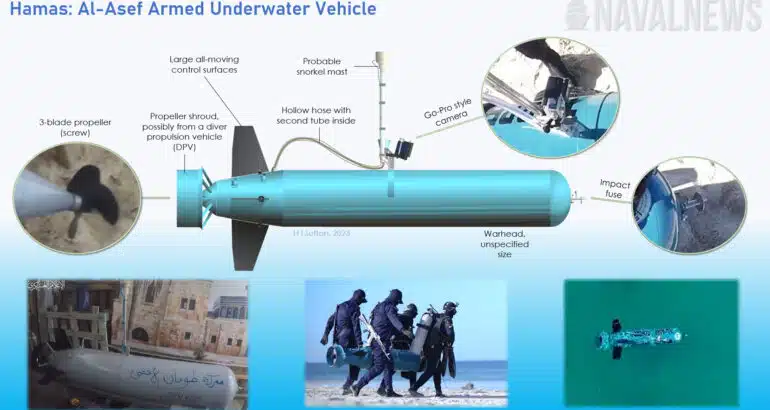Los Sistemas Autónomos Submarinos (UUV – Unmanned Underwater Vehicle) están cada vez más presentes en las guerras modernas. Y no solo los que tienen capacidad de vigilancia y reconocimiento, sino también los letales. Si bien muchos países tienen programas de desarrollo, también existen organizaciones terroristas y fuerzas irregulares que los obtienen, desarrollan y emplean. Es el caso de Hamás, que ha presentado en un video promocional su sistema UUV “Al-Asef”. Este sistema sería producido localmente por Hamas y se informó que fue empleado para atacar blancos israelíes. Si bien no se conocen características técnicas del UUV, un análisis de las imágenes disponibles permite revelar algunos detalles de este sistema que, aunque rudimentario y de bajo costo, constituye una amenaza que debe ser tenida en cuenta.
Hamas has shown a promotional video of its ‘Al-Asef’ guided ‘torpedo’. The locally produced weapon has reportedly been used against multiple Israeli targets. This gives us our first look at this type of weapon in service with Hamas.
Little information about the weapon has been shared by Hamas. However analysis of the imagery reveals several details.
It appears to be a basic semi-submerging uncrewed underwater vehicle (UUV). The nose appears to feature a rudimentary impact fuse for a modest sized explosive warhead. It is guided by a go-pro style camera which is mounted near to the body. This suggests only very shallow diving during the attack, more of a semi-submersible than a true underwater vehicle.
Description of the New Weapon
The torpedo-like body is metal, allowing for a modest diving depth. Possibly it is assembled from compressed gas cylinders. It does not appear to have a sophisticated buoyancy system so diving depth is likely controlled by the large surfaces at the back. The rear screw (propeller) and shroud may to have come off a vintage diver propulsion vehicle (DPV).
It is unclear whether it uses batteries for propulsion or some form of internal combustion engine. However a hollow hose runs along the outside of the vehicle to what may be a snorkel mast. This implies the latter, an internal combustion engine, possibly gasoline. If so, then the engine is about the same size as those on uncrewed air vehicles (UAVs).
The use of a human to guide it simplifies the sensor and control setup but relies on reliable communications with the pilot. This may make it susceptive to jamming.
The weapon has been shown being carried into the water by four Hamas divers of the Al-Qassam Brigades. It has apparently been used during the 7 October 2023 Hamas led attack on Israel from Gaza, which has been called operation Al-Aqsa Flood. This fact is unverified, but the weapon’s existence is clear. Based on the available video evidence at least two of the weapons have been built, but likely more.
Proliferation Of These Weapons
Although the images offer new details, the existence of Hamas’ underwater ‘torpedoes’ were publicly known. In May 2021 the Israeli government reported that Hamas attempted to attack Israeli naval assets with a similar weapon. That was launched from northern Gaza, in the vicinity of 31.529581°, 34.437747°. Both the weapon and the team that launched it were quickly neutralized by Israeli forces.
Similar weapons, which combine features of torpedoes and underwater drones, have been built by Iran and North Korea. And possibly Hezbollah in Lebanon and the Houthi Movement in Yemen have something similar. All of these could be an influence. The Iranian ones are more professional, like a long ranged torpedo. And the North Korean Haeil family is much larger and heavily armed, possibly with a nuclear warhead.
So there is no doubt that these weapons are more formidable. But this doesn’t mean that the Al-Asef torpedo won’t be taken seriously. It is part of a wider trend of weaponizing uncrewed maritime drones.
Fuente: https://www.navalnews.com


